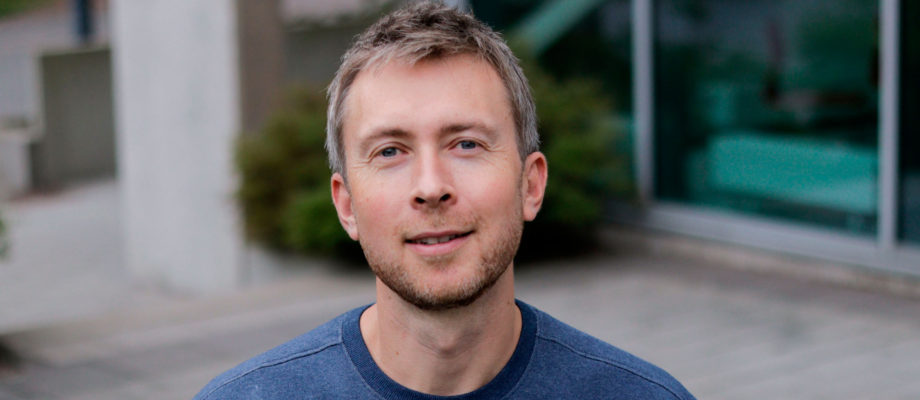DISTINCTIONS. Erik Larsson Lekholm is this year’s recipient at Sahlgrenska Academy of the Young Fernström Prize, or as the prize is officially known, the Eric K. Fernström Prize for young, particularly promising and successful researchers. Earlier this year Erik was also appointed professor of bioinformatics, with a special focus on large-scale analysis of DNA and RNA.
The personal prize of SEK 90,000 is timely, Erik tells me when I meet him in his room at the Department of Medical Biochemistry and Cell Biology at Medicinareberget. He has just returned after a year as a guest researcher at Cancer Research UK in Cambridge, but because his wife Julia Morud Lekholm remains as a postdoc at Cambridge, he continues to commute weekly to his family in England.
“I’ve just purchased 15 round-trip tickets to Stansted. It’s actually quite convenient to travel every weekend, but it means some extra costs, although fortunately much is covered by scholarships and grants. Child care facilities, in particular, are considerably more expensive in the United Kingdom than in Sweden.”
Underrepresented area
He thinks, of course, that receiving the prize is really great, but he is especially pleased that it calls attention to bioinformatics in Gothenburg.
“Large-scale sequencing has become inexpensive and available, and biomedical research is moving more and more into computers. Technological developments are happening extremely fast, and more bioinformatics is needed at Sahlgrenska Academy or this can become a bottleneck. We are essentially the only team here on the faculty focusing on bioinformatics, and we hardly have time to collaborate with all those who want to include us in their projects.”
His team currently has nine members: Erik, four doctoral students and four postdocs. They work with many different types of cancer, sometimes 10 or more in the same study. In some projects they focus on individual cancers, collaborating with teams that have a more experimental focus. They are searching for genetic changes that recur in cancer cells from many patients, and they are also working on developing methods that can be used to distinguish important genetic changes from mutations that are not harmful.”

On his desk is a large pile of new hard drives, which will become a new server for the enormous amounts of data the team works with. But the servers the team has access to at Medicinareberget are not sufficient. They also need to use the Swedish supercomputer facility in Uppsala known as UPPMAX (Uppsala Multidisciplinary Center for Advanced Computational Science).
A wet lab of its own
Erik Larsson Lekholm’s research on mutations in cancer is groundbreaking, according to the prize committee’s explanatory statement. By combining bioinformatics and experimental methods, he has increased understanding of how mutations occur and are distributed among the cells’ chromosomes, providing better possibilities to interpret the information and to identify specific changes in DNA that may be important in various cancers.
Much of the genetic information team members work with has been obtained from The Cancer Genome Atlas (TCGA) cancer consortium and other public sources, but they can also sequence materials themselves to produce data for research. The team’s potential for generating its own sequencing data has recently been improved considerably since it received a wet lab of its own in which to work.

“Kerryn Elliott, a postdoc on the team, is the one who established the wet lab, and it has really proven to be a valuable asset,” says Erik.
As an example, he notes a study that he is going to submit to a journal later that afternoon in which the team has developed a whole genome map showing where DNA damage caused by ultraviolet light occurs. In this project the team has exposed cells to UV light and only seconds afterward, before the cells’ repair processes got under way, examined where the damage occurred.
“Having a wet lab of our own in addition to our bioinformatic methods is a powerful combination. When we find interesting things in the public cancer data, we now also have a more direct way of being able to follow up the findings experimentally and validate them. It’s much more cumbersome if you first have to initiate collaborations.”
TEXT AND PHOTO: ELIN LINDSTRÖM CLAESSEN
ABOUT ERIC K. FERNSTRÖM
Eric K. Fernström was born in Karlshamn in 1901. He began his career as a successful manager for his family’s granite company. The company’s black dolerite covers the base facade of the Empire State Building in New York. In 1978, the Eric K. Fernström Foundation was founded to promote scientific medical research. The Foundation presents prizes to outstanding medical researchers. Among other things, the Eric K. Fernström Foundation annually presents six prizes of SEK 90,000 each to relatively young, particularly promising and successful researchers. One researcher from each of Sweden’s six medical schools is recognized.











